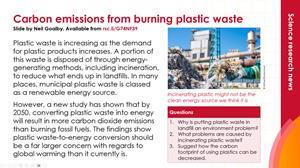Carbon emissions from incinerating waste plastic are having a bigger impact on the climate emergency than previously thought
-

Download this
Use this story and the accompanying summary slide for a real-world context when studying climate change with your 14–16 learners.
Download the story as MS Word or PDF and the summary slide as MS PowerPoint or PDF.
Converting plastic waste into energy results in more carbon dioxide emissions per unit of power generated than burning fossil fuels, a study by researchers in South Korea has found. Their findings show that using plastic waste to generate energy should be a much bigger concern than it currently is in the context of the climate emergency.
Some plastic waste is currently disposed of through energy-generating methods to reduce the amount of plastic ending up in landfills. Pyrolysis is one example, where plastic is converted into a gas or oil and then burned to produce steam, which is then used to produce electricity through a turbine. Another is gasification, where waste plastic is heated with air or steam to produce a gas mixture called syngas. This gas is then burned to generate electricity or used to produce diesel and petrol.
In some countries, municipal solid waste containing plastic is classified as a renewable energy source. There is, however, a growing concern that using waste plastic in this way is contributing to the climate emergency.

Determining the impact
Seong-kyun Im of Korea University and colleagues have modelled the emissions from a range of different plastic waste-to-energy methods. They found that carbon dioxide emissions from pyrolysis and gasification processes are higher than those from current fossil fuel-based power systems, per unit of power generated. This is a growing problem, they conclude, thanks to the volume of plastic waste increasing unabated.
The scientists believe we should not ignore carbon dioxide emissions associated with generating electricity from plastic waste. They believe that more effort is needed to develop efficient and effective carbon separation, capture and storage technologies to bolt onto plastic pyrolysis and gasification plants, to offset this growing contributor to the climate emergency.
Put this in context
Find out what the chief executive officer of an innovative start up company is doing to help the world to reach net-zero carbon emissions.
This article is adapted from Cat Schofield’s in Chemistry World.
In some countries, municipal solid waste containing plastic is classified as a renewable energy source
Nina Notman
Reference
S Kwon et al, Energy Environ. Sci., 2023, DOI: 10.1039/d3ee00969f
Download this
Summary slide with questions and the article for context when teaching your 14–16 classes climate change: rsc.li/3XTbLLq
Downloads
EiC summary slide Incinerating plastic
Presentation | PDF, Size 0.27 mbEiC summary slide Incinerating plastic
Presentation | PowerPoint, Size 1.36 mbEiC science research story Incinerating plastic
Handout | PDF, Size 0.16 mbEiC science research story Incinerating plastic
Word, Size 0.61 mb














2 readers' comments